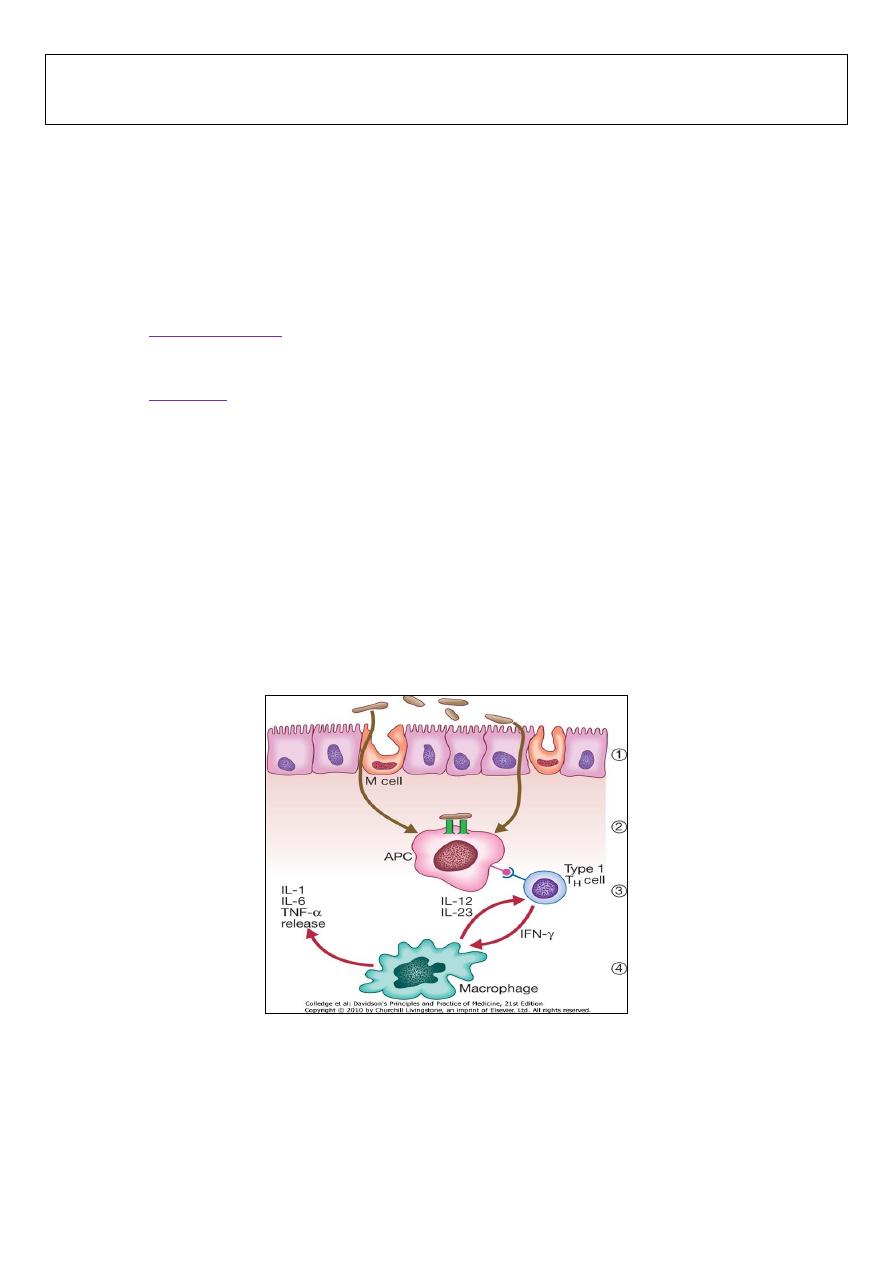
1
THI QAR U. MEDICAL COLLEGE GIT LECTURES 2020
DEPARTMENT OF INTERNAL MEDICINE
Dr. Faez Khalaf,
SUBSPACIALITY GIT
Inflammatory bowel diseases
Ulcerative colitis and Crohn's disease
An immune-mediated chronic inflammatory bowel diseases with relapsing and remitting course
• ulcerative colitis only involves the colon
• Crohn's disease can involve any part of the gastrointestinal tract from mouth to anus.
Epidemiology
• In developing world
• Crohn's disease appears to be rare
• Ulcerative colitis, more common.
•
• In the West
• ulcerative colitis prevalence of 100-200 per 100 000
• Crohn's disease prevalence of 50-100 per 100 000.
•
young adults (between
15 and 30 years
) , second smaller incidence peak in the seventh decade
(between
60 and 80 years
)
•
The male to female ratio for UC is
1:1
and for CD is
1.1–1.8
.
•
UC and CD have
two- to fourfold
increased frequency in Jewish.
Etiology
• abnormal host response to an environmental trigger in genetically susceptible individuals
• This causes inflammation of the intestine and release of inflammatory mediators, such as TNF,
IL-12
and
IL-23
, which cause tissue damage.
Factors associated with the development of IBD Genetic
1. More common in Ashkenazi Jews
2.
10%
have a first-degree relative or at least one close relative with IBD
3. High concordance between identical twins
4. Some abnormal genes detected
5. Associated with autoimmune thyroiditis and SLE
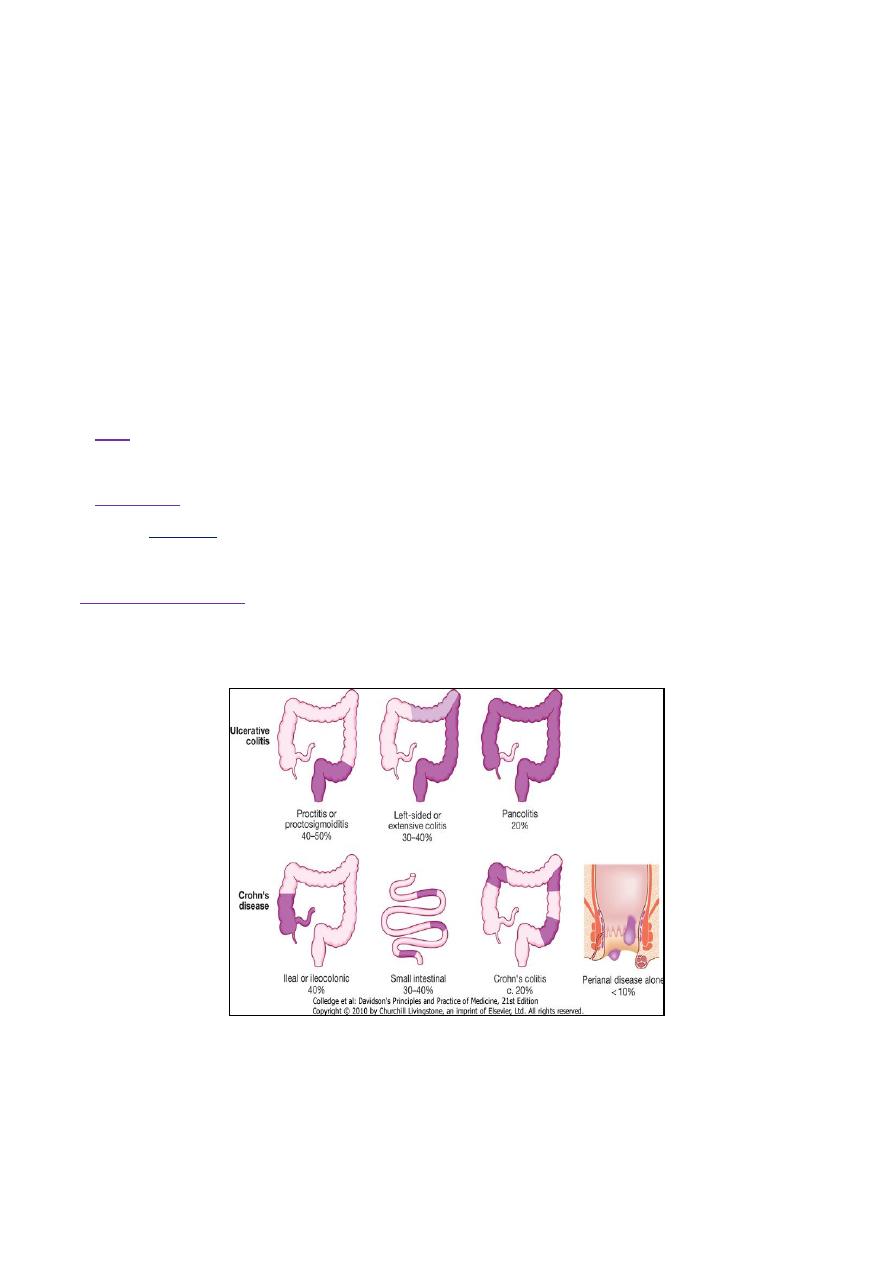
2
Environmental
a. Ulcerative colitis is more common in non-smokers and
ex-
smokers.
2. Most Crohn's patients are smokers
3. CD associated with low-residue, high-refined-sugar diet
4. Commensal gut microbiota altered (dysbiosis) in CD and UC
5. Appendicectomy protects against ulcerative colitis
Pathology
Ulcerative Colitis
Macroscopic Features
• Extends proximally to involve all or part of the colon.
•
40–50%
of patients involve the rectum , recto sigmoid
•
30–40%
beyond the sigmoid
•
20%
have a total colitis
• Inflammation is
diffused
Mild:
• the mucosa is erythematous and fine granular surface
More severe
• the mucosa is hemorrhagic, edematous, and ulcerated (superficial diffused)
•
Fulminant
disease can develop a toxic megacolon where the bowel wall thins and the mucosa is
severely ulcerated; this may lead to perforation.
In long-standing disease
• Inflammatory polyps (pseudo polyps) may be present as a result of epithelial regeneration.
• many years of disease it appears atrophic and featureless and the entire colon becomes narrowed and
shortened
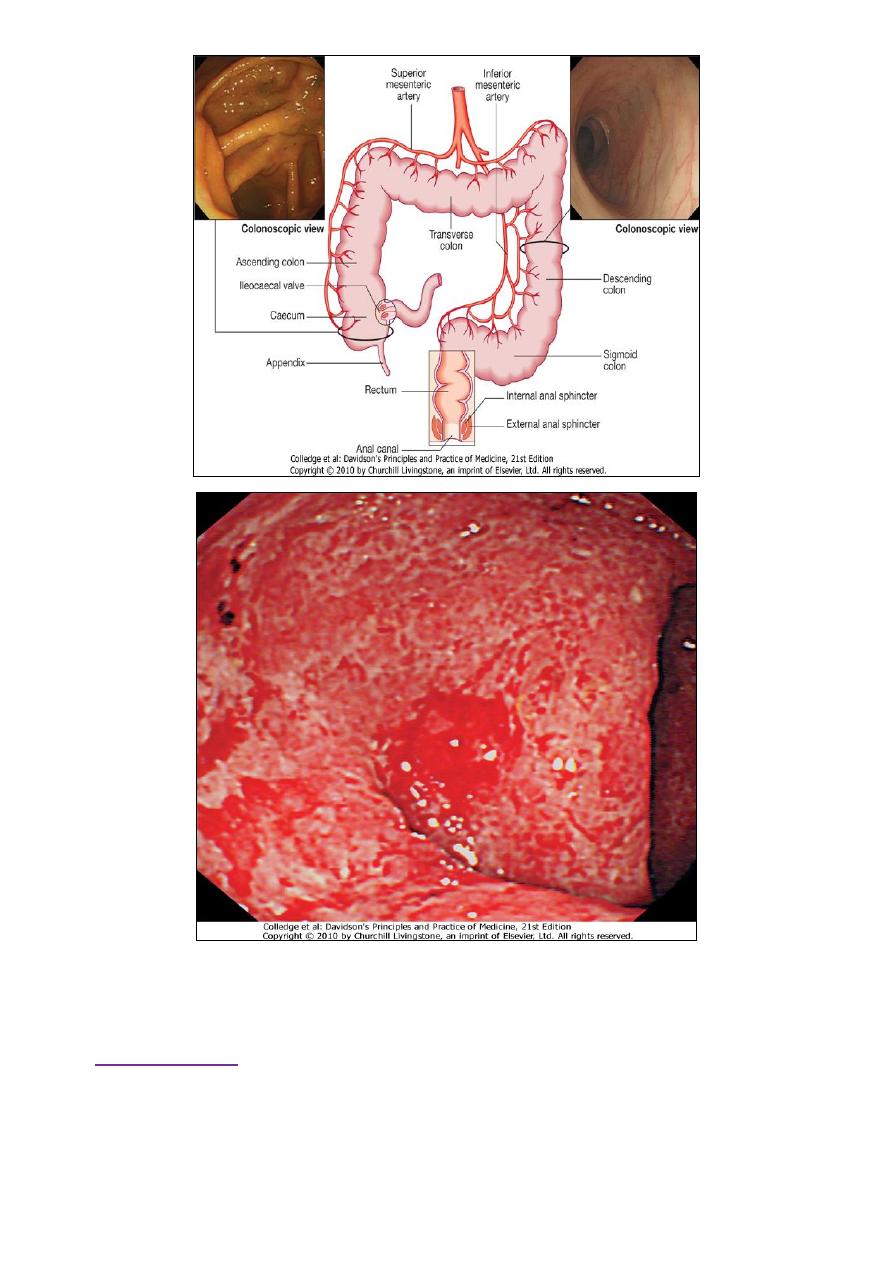
3
Ulcerative Colitis
Microscopic Features
• Mucosal vascular congestion, edema and focal hemorrhage
• Inflammatory cell infiltrate of neutrophils, lymphocytes, plasma cells, and macrophages may be
present.
• The neutrophils invade the epithelium, usually in the crypts, giving rise to cryptitis and, to crypt
abscesses
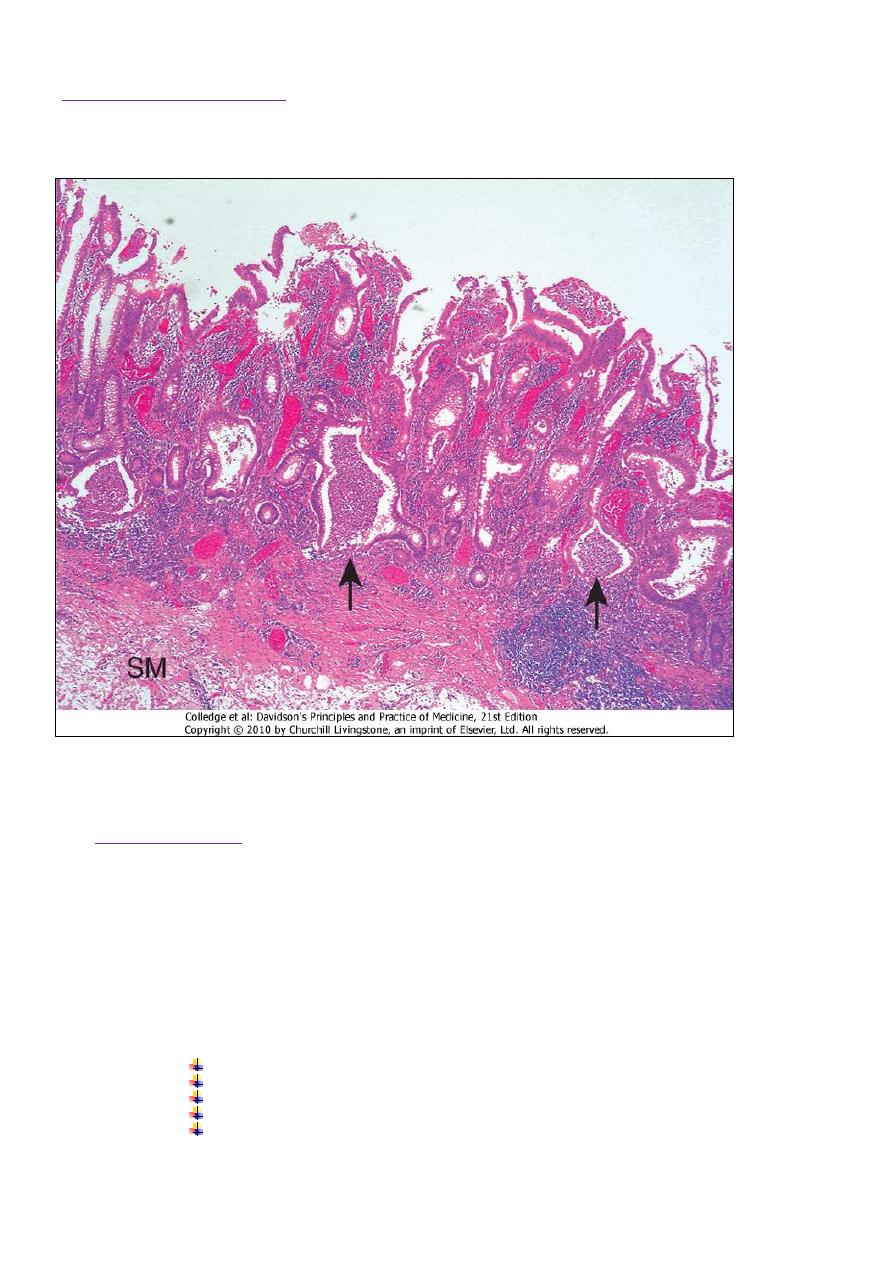
4
Histological features of chronicity
• First, the crypt architecture of the colon is distorted
• Second, some patients have basal plasma cells and multiple basal lymphoid aggregates
Crohn's Disease:
Macroscopic Features
•
30–40%
of patients have small-bowel alone
•
40–55%
have disease involving the ileum and the Rt colon
•
15–25%
have colitis alone.
•
30 %
have anal involvement
• the rectum is often spared in CD.
• segmental inflammation (skip areas of inflammation)
• Aphthous ulcerations
• Stellate ulcerations fuse longitudinally and transversely to demarcate islands of mucosa that
frequently are histologically normal. "cobblestone" appearance
• Ulcers may penetrate bowel wall to initiate abscesses or fistulas
the bowel
bladder
uterus
vagina
skin of the perineum
• Bowel narrowed and fibrotic, with chronic, recurrent bowel obstructions
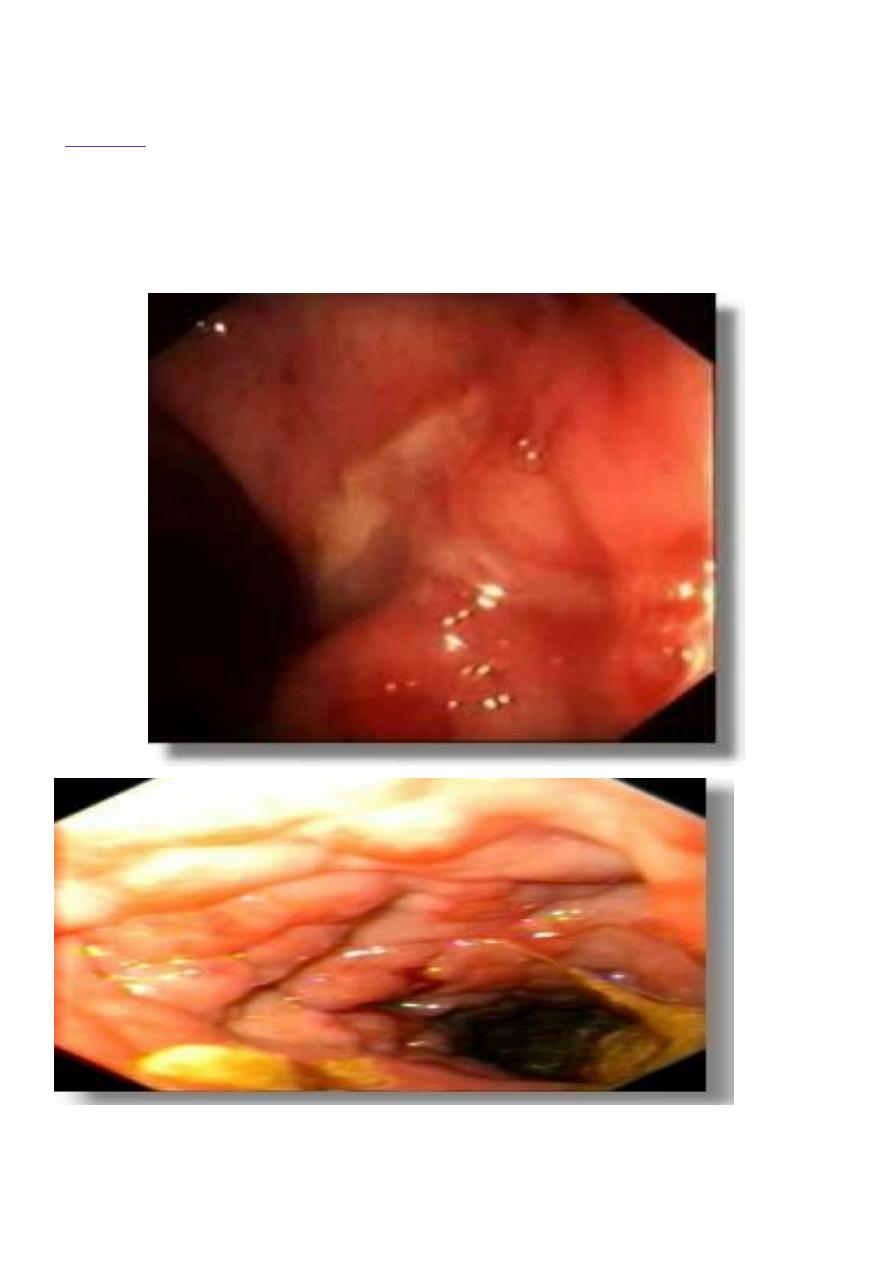
5
• Mesenteric lymph nodes are enlarged and the mesentery is thickened.
Microscopic
• trans mural inflammation
• fissures penetrate deeply into the bowel wall
• bowel wall thickened
• Chronic inflammatory infiltrate all layers.
• focal crypt abscesses
• noncaseating granulomas
• microscopic skip areas
• Other histologic features sub mucosal or subserosal lymphoid aggregates.
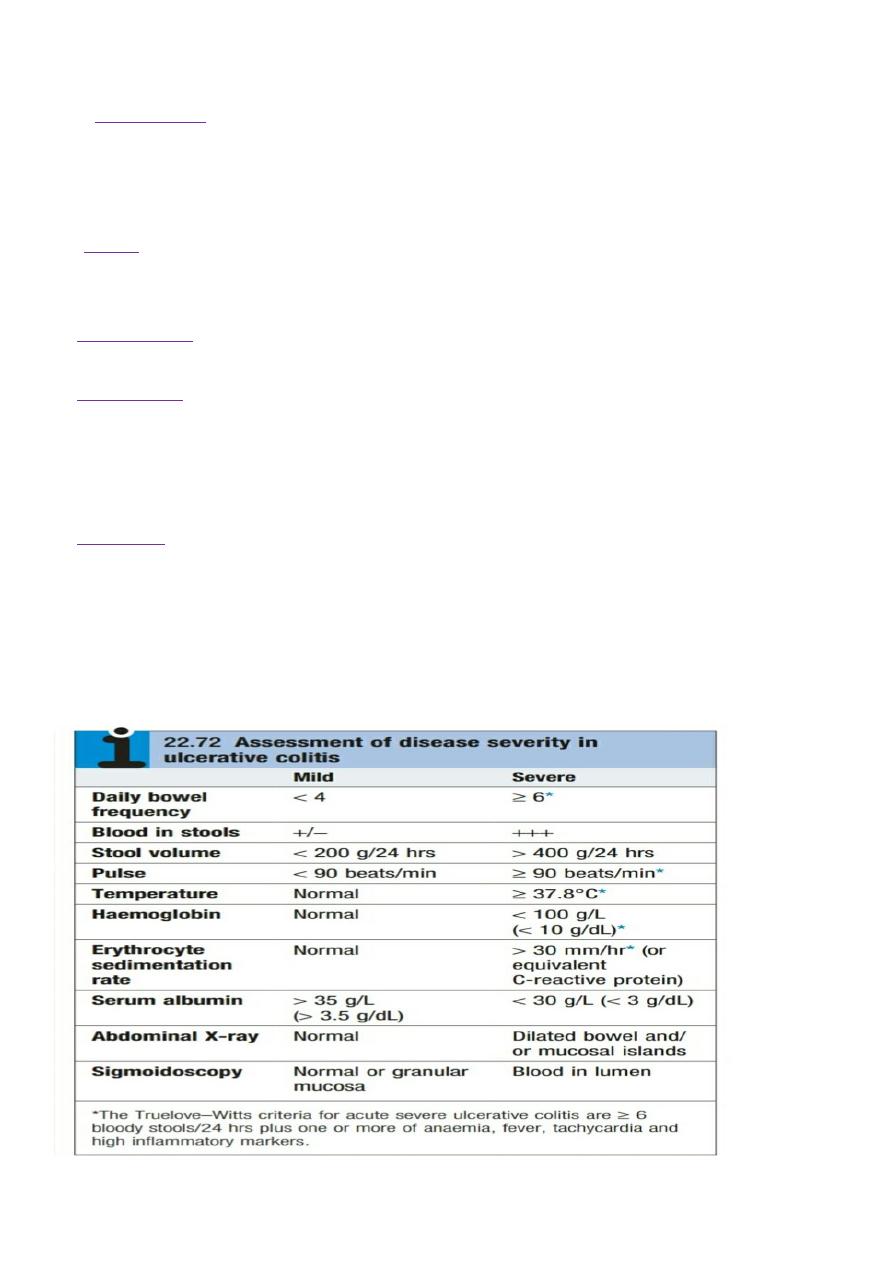
6
Clinical features
Ulcerative colitis
Bloody diarrhoea relapses and remissions
1. Emotional stress
2. intercurrent infection
3. gastroenteritis
4. antibiotics
5. NSAID therapy may all provoke a relapse
Proctitis
• Rectal bleeding
• mucus discharge
• Tenesmus.
• frequent, small-volume fluid stools
Proctosigmoiditis
• Bloody diarrhoea with mucus.
Extensive colitis
• bloody diarrhea
• Passage of mucus.
• Severe cramping
• Abdominal pain can occur with severe attacks of the disease.
• Constitutional symptoms do not occur only in moderate to severe disease
Severe colitis
• Bleeding
• Severe diarrhea
• severe pain
• fever
• Tachycardia
• Abdominal tenderness
• Edema
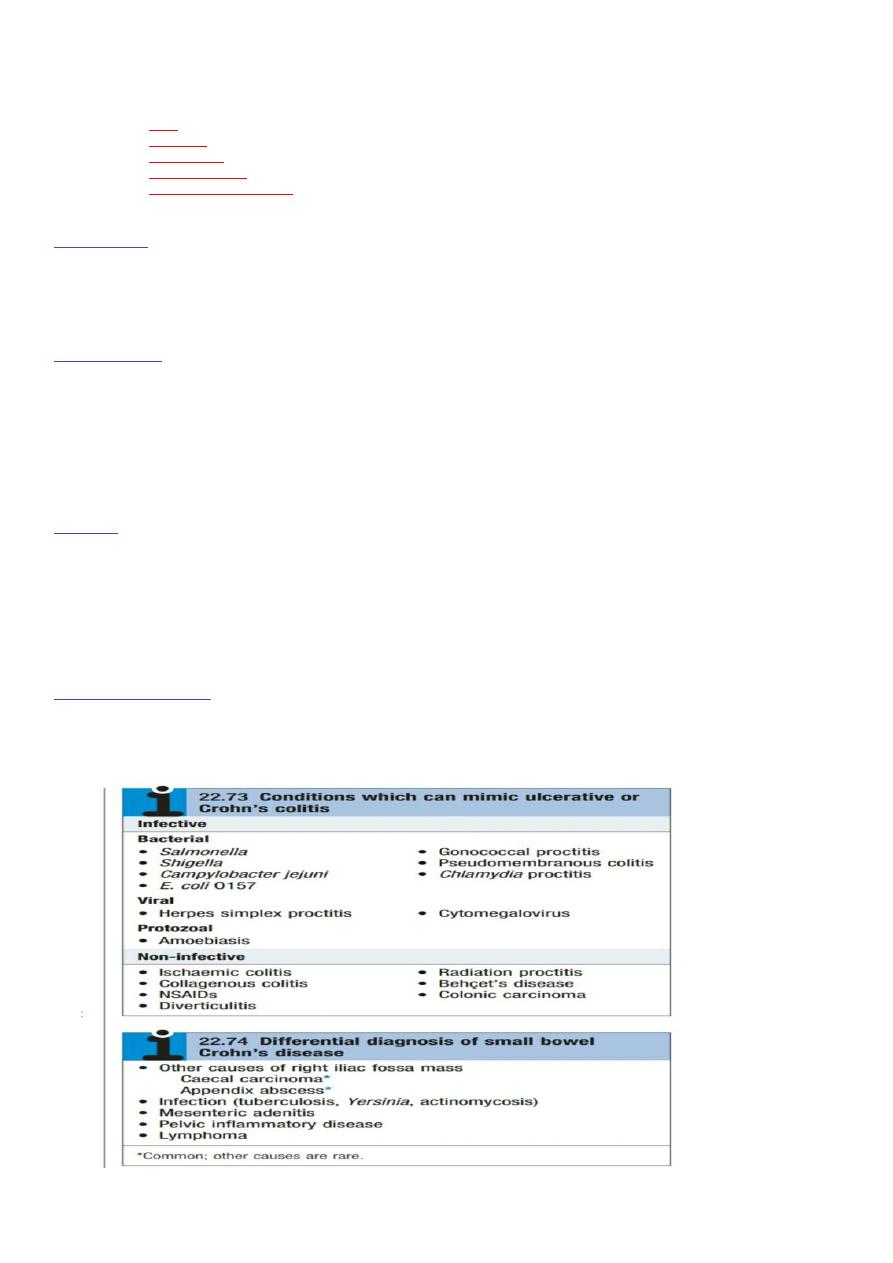
7
Crohn's Disease
• The major symptoms are
•
pain
is often associated with diarrhea
•
Diarrhea
usually watery not contain blood or mucus.
• weight loss
• malabsorption
•
intestinal obstruction
sub-acute or even acute
Crohn's colitis
• as ulcerative colitis
• rectal sparing
• Structuring can occur in the colon
Perianal disease
• affects about one-third of
• large hemorrhoid tags
• anal strictures
• anorectal fistulae
• Perirectal abscesses.
• incontinence
Ileocolitis
• Recurrent right lower quadrant pain
• Diarrhea.
• palpable mass
• Fever, leukocytosis.
• Weight loss is common
• fistula formation
• abscess cavity in the mesentery
Small intestinal Crohn's
• Malabsorption and steatorrhea.
• Nutritional deficiencies.
Vomiting from jejunal strictures or severe oral ulceration
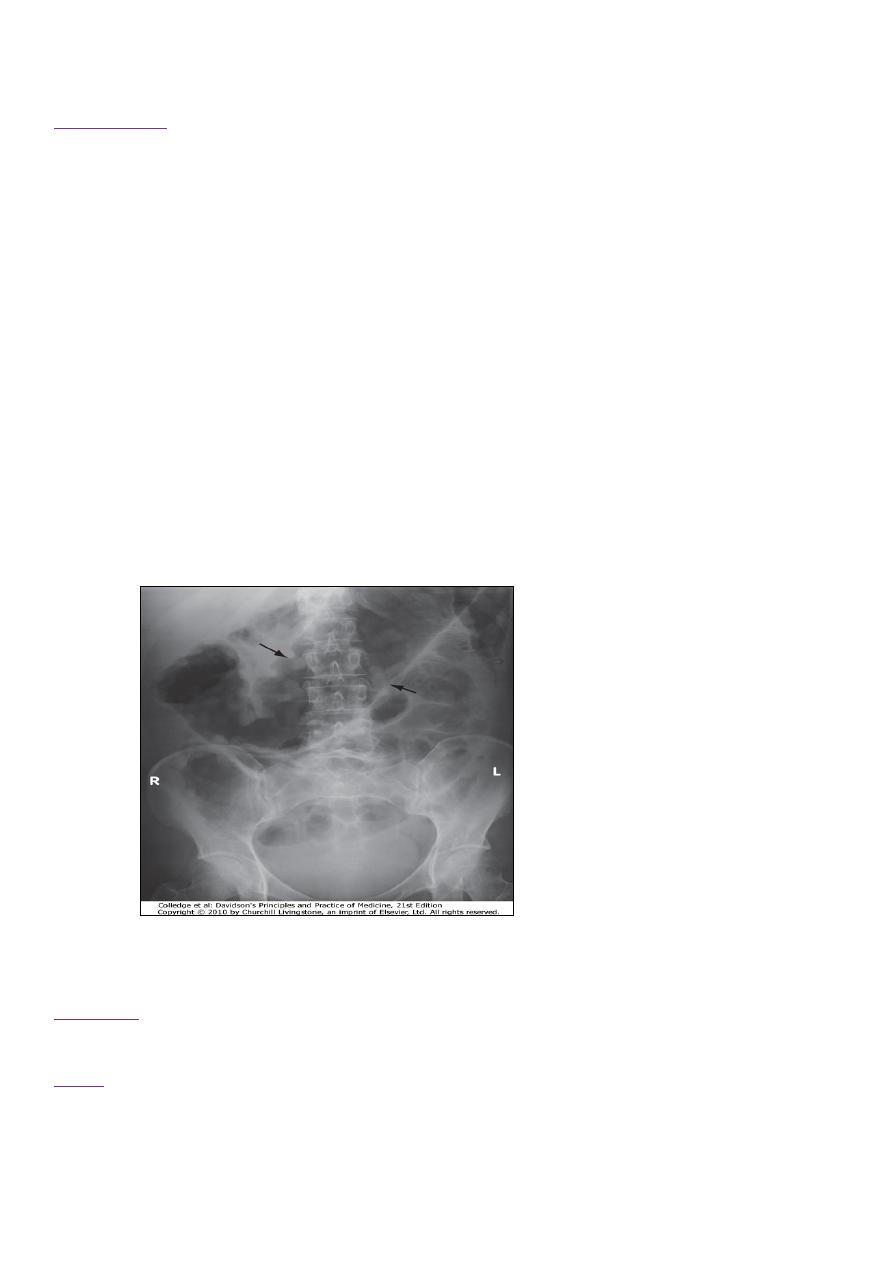
8
Complications
Toxic megacolon
Acute colonic dilatation due severe flare of the colitis
More with extensive colitis
5%
incidence
Precipitating factors as hypokalemia , antimotility, colonoscopy
Clinical features
Features of severe colitis with
Diffused abdominal distension
Diffused tenderness
Decease bowel sound
Lab sings of systemic inflammation
Treatment
Conservative
Indication for surgery
No response within
72 hr.
Sings of peritonitis or perforation
Hemorrhage
• Acute Haemorrhage (major artery) is rare
Fistulas
Enteroenteric
diarrhoea
malabsorption.
Enterovesical
recurrent UTI
pneumaturia.
Enterovaginal
a feculent
vaginal discharge.
Note: Toxic megacolon. Transverse colon diameter> 6 cm
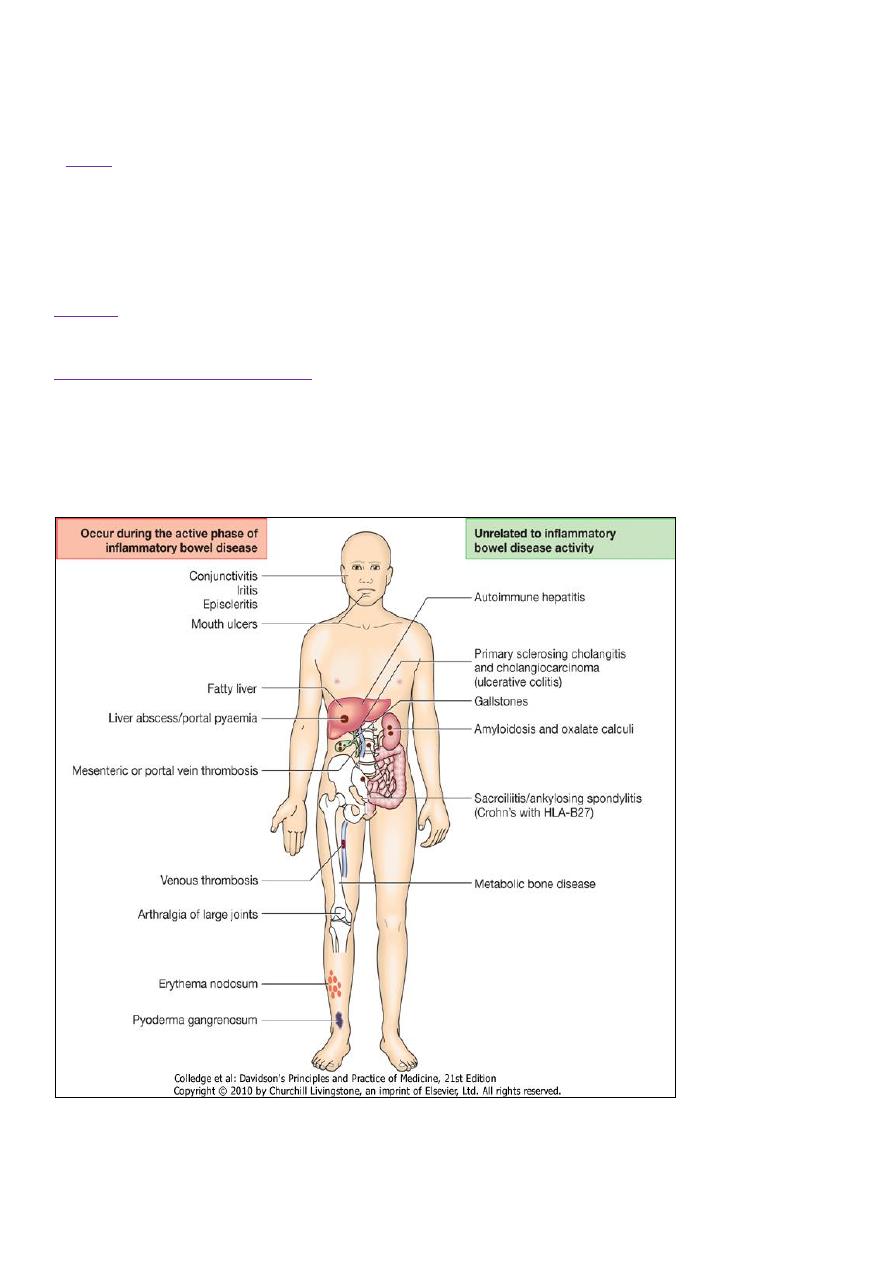
9
Bowel fistulation
perianal
ischiorectal
Abscesses
Fissures
.
Cancer
• Active colitis of more than 8 years'.
• The cumulative risk 10%
• Lower for Crohn's colitis.
• Tumors develop in areas of dysplasia
• Surveillance programmes beginning 8 years after diagnosis by colonoscopy 1-2-yearly.
• Moderate-high-grade dysplasia panproctocolectomy
Strictures
In Crohn's disease
Extra intestinal complications
• common in IBD
• May dominate the clinical picture.
• Some of these occur during relapse of intestinal disease
• others unrelated to intestinal disease activity
• Include skin, joints, mouth, hematological, coagulopathy, eye and hepatobiliary
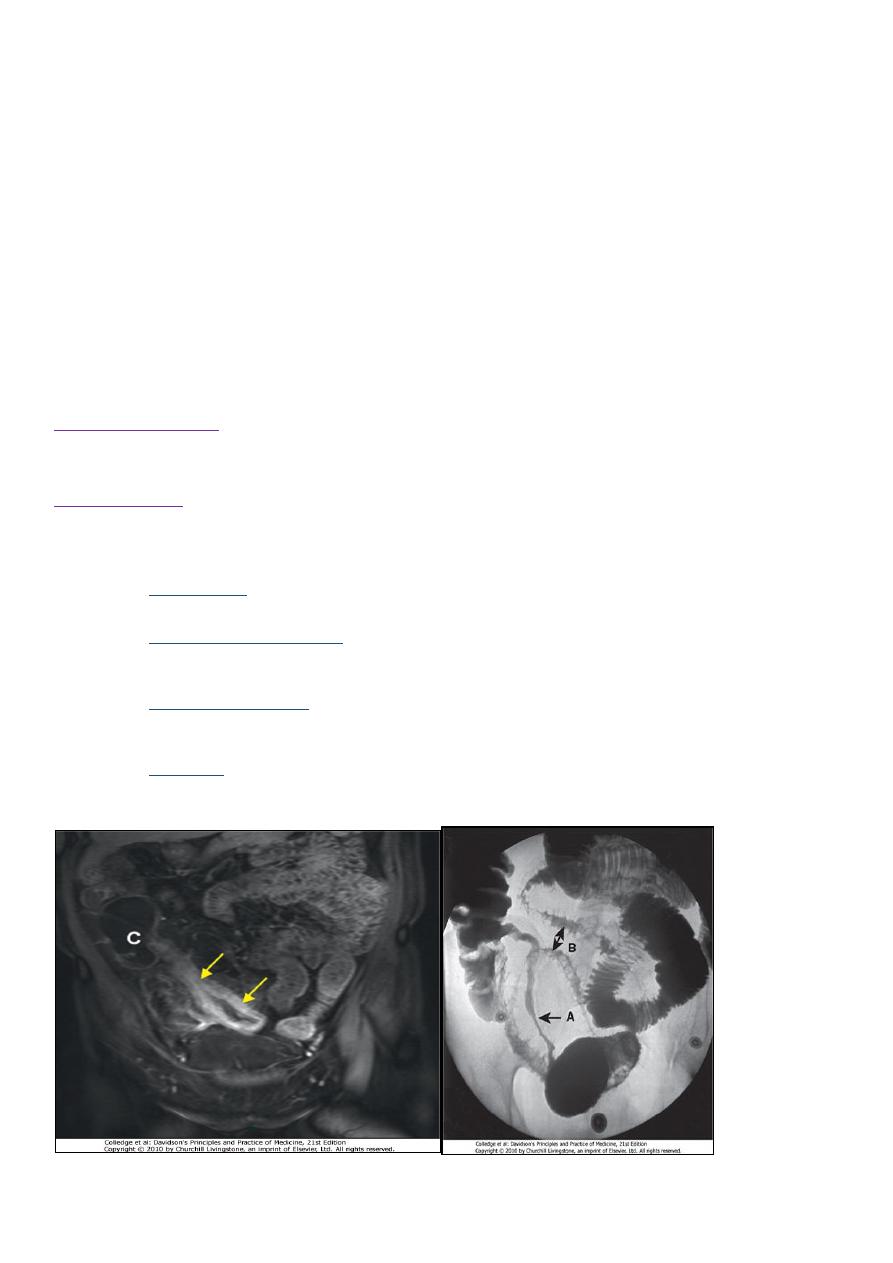
10
Investigations
• confirm the diagnosis
• define disease distribution
• define activity
• Identify complications.
•
Full blood count
may show anemia
• Serum albumin.
• The ESR and CRP
• elevated in exacerbations and in response to abscess formation
Bacteriology
Stool microscopy
Culture and examination
Ova
Cysts
Clostridium difficile toxin
Blood cultures
Endoscopy with Biopsies
• Confirm the DX
• define disease extent
• Detect dysplasia in long-standing colitis.
Capsule endoscopy
• The identification of small bowel inflammation.
Radiology
• Barium enema
• less sensitive investigation than colonoscopy
• Crohn's disease; affected areas are narrowed and ulcerated, and multiple strictures are common
• Abdominal CT and MRI scans
• provide bowel thickening
Pelvic or perineal involvement.
• A plain abdominal X-ray
Dilatation of the colon
In small bowel Crohn's disease there may be evidence of intestinal obstruction
•
Ultrasound
• thickened small bowel loops
Abscess development in Crohn's

11
Management
• Treat acute attacks
• Prevent relapses
• Select patients for surgery
• Detect carcinoma at an early stage
Treat acute attacks
Aminosalicylates
Mode of action: modulate cytokine release
Oral or topical (enema/suppository)
Mesalamine
• Pentasa (time dependent release)
• Ascol ( PH dependent release)
With carrier
• Sulfasalazine, balsalazide, olsalazine
Side-effects
10-45%
headache
nausea
diarrhoea
blood dyscrasia
Corticosteroids
Anti-inflammatory
Topical and oral and I.V
prednisolone
hydrocortisone
Budesonide
Cyclosporine
Suppresses T-cell expansion
Rescue' therapy to prevent surgery in severe ulcerative colitis responding poorly to corticosteroids.
No value in Crohn's disease
Major side-effects in
Nephrotoxicity, infections, neurotoxicity
Minor complications:
Tremor, paresthesia, abnormal liver function tests, hirsutism
Anti-TNF antibodies
(Infliximab and adalimumab)
• Suppress inflammation and induce apoptosis of inflammatory cells
• Fistulating Crohn's disease
• Severe active ulcerative colitis with no response to steroids or cyclosporine
Side effects:
• Anaphylactic reactions
• Contraindicated in the presence of infections; reactivation of tuberculosis
Antibiotics
• Useful in perianal Crohn's disease
Antidiarrheal agents
(codeine phosphate, lope amide, lomotil)
Reduce gut motility and small bowel secretion
Avoided in acute flare-ups of disease

12
May precipitate colonic dilatation
Prevent relapses
Thiopurines
(Azathioprine, 6-mercaptopurine)
Immunomodulation by inducing T-cell cytotoxic effect
Effective after
12 weeks
of starting therapy
Complications :
Flu-like syndrome with myalgia
Leucopenia in
3%
Methotrexate
• Anti-inflammatory (folic acid antagonist)
• Nausea, stomatitis, diarrhoea, hepatotoxicity and pneumonitis
• Used in Crohn's disease
Anti-TNF antibodies (infliximab)
Ulcerative colitis
Active proctitis and Proctosigmoiditis
• Mesalamine enemas or suppositories combined with oral mesalamine are effective first-line therapy.
• Topical corticosteroids for intolerant of topical mesalamine.
Active left-sided or extensive colitis
• high-dose aminosalicylates
• Oral prednisolone 40 mg daily is indicated for more active disease or when initial aminosalicylate
therapy is ineffective
Severe ulcerative colitis
Hospital admission
monitored clinically: for the presence of abdominal pain, temperature, pulse rate, stool blood and frequency
Radiologically: for colonic dilatation on plain abdominal X-rays.
intravenous fluids
Transfusion blood if
Hb < 10 g/L
nutritional support
IV corticosteroids
Oral aminosalicylates.
Patients who do not promptly respond to corticosteroids are considered for intravenous ciclosporin or
infliximab
Those who do not respond after ' maximal medical treatment usually require urgent colectomy.
Maintenance of remission
Life-long therapy
recommended
Extensive disease
Distal disease who relapse more than once a year.
Drugs:
Oral aminosalicylates first line
Patients who frequently relapse despite aminosalicylate drugs are treated with Thiopurines.

13
Crohn's disease
Active colitis or ileocolitis
• Aminosalicylates
• corticosteroids
• In severe disease intravenous steroids
Isolated ileal disease
• Corticosteroids.
• Amino salicylates have little added value
• Biological treatment
Fistulas and perianal disease.
• Surgical intervention required for abscess
• For simple perianal disease metronidazole and/or ciprofloxacin are first-line therapies.
• Treatment of underlying active disease with corticosteroids.
• Infliximab heal enter cutaneous fistulas and perianal disease in many patients.
Maintenance of remission
Aminosalicylates have minimal efficacy.
Thiopurines for relapse more than once a year or severe disease.
Patients who are intolerant of or resistant to Thiopurines should be treated with once-weekly methotrexate
combined with folic acid.
Patients with aggressive disease are managed using a combination of immunosuppressive and anti-TNF
therapy.
Indications for surgery in ulcerative colitis
Failure of medical therapy
• Failure of remission induction (severe colitis)
• Toxic megacolon no response to Rx
• Failure of remission
• Complications of drug therapy
Disease complications unresponsive to medical therapy
• Arthritis , Pyoderma gangrenosum
Colon cancer or severe dysplasia
Impaired quality of life
• Loss of occupation or education
• Disruption of family life
Indications for surgery in Crohn's disease
• The indications for surgery are similar to those for ulcerative colitis.
• Unresponsive fulminant disease
• Operations are often necessary to deal with abscesses
• Relieve small or large bowel stricture.
• Chronic Fistulating small bowel disease may require resection if no response
